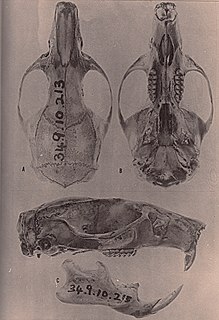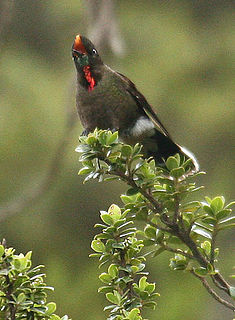
Ecuador, officially the Republic of Ecuador, is a country in northwestern South America, bordered by Colombia on the north, Peru on the east and south, and the Pacific Ocean on the west. Ecuador also includes the Galápagos Islands in the Pacific, about 1,000 kilometers (621 mi) west of the mainland. The capital is Quito.

The Galápagos Islands, part of the Republic of Ecuador, are an archipelago of volcanic islands. They are distributed on either side of the equator in the Pacific Ocean, surrounding the centre of the Western Hemisphere. Located 906 km (563 mi) west of continental Ecuador, the islands are known for their large number of endemic species that were studied by Charles Darwin during the second voyage of HMS Beagle. His observations and collections contributed to the inception of Darwin's theory of evolution by means of natural selection.

Loja Province is one of 24 provinces in Ecuador and shares its southern border on the west with El Oro Province, on the north with El Azuay, and on the east with Zamora-Chinchipe. Founded on its present site in 1548 by Captain Alonso de Mercadillo (Spanish), the site had been previously moved and rebuilt from La Toma due to earthquakes. It also is named as "Cuxibamba Valley", from the Quichua language, which means the "Smiley Valley".

Aiphanes is a genus of spiny palms which is native to tropical regions of South and Central America and the Caribbean. There are about 26 species in the genus, ranging in size from understorey shrubs with subterranean stems to subcanopy trees as tall as 20 metres (66 ft). Most have pinnately compound leaves ; one species has entire leaves. Stems, leaves and sometimes even the fruit are covered with spines. Plants flower repeatedly over the course of their lifespan and have separate male and female flowers, although these are borne together on the same inflorescence. Although records of pollinators are limited, most species appear to be pollinated by insects. The fruit are eaten by several birds and mammals, including at least two species of amazon parrots.

The glass frogs are frogs of the amphibian family Centrolenidae. While the general background coloration of most glass frogs is primarily lime green, the abdominal skin of some members of this family is transparent and translucent. The internal viscera, including the heart, liver, and gastrointestinal tract, are visible through the skin, hence the common name is given as glass frog. Glass frogs are arboreal, meaning they mainly live in trees, and only come out for mating season.
Hylaeamys yunganus, also known as the Amazonian oryzomys or Yungas rice rat, is a species of rodent in the genus Hylaeamys of family Cricetidae. It is found in lowland tropical rainforest throughout Amazonia, in northeastern Bolivia, eastern Peru, eastern Ecuador, southeastern Colombia, southern Venezuela, Guyana, Suriname, French Guiana, and northern Brazil. A closely related species, Hylaeamys tatei, occurs only in a small area in eastern Ecuador. Both were previously placed in Oryzomys.

The largenose catshark is a catshark of the family Scyliorhinidae. The largenose catshark is found on the upper continental slopes in the eastern Pacific, from the Gulf of Panama to Ecuador and central Chile, between 9°N and 28°S. It can grow up to 70 cm. Its reproduction is oviparous. This nose shark is considered to be a harmless species. It is known to originate from the Gulf of Panama, Ecuador, and Central Chile.

Desmoncus is a genus of mostly climbing, spiny palms native to the Neotropics. The genus extends from Mexico in the north to Brazil and Bolivia in the south, with two species present in the southeastern Caribbean.
Nephelomys albigularis, also known as the white-throated oryzomys or Tomes's rice rat, is a species of rodent in the genus Nephelomys of family Cricetidae. Described in 1860, it was the first Nephelomys species to be discovered. It was originally described in the defunct genus Hesperomys as Hesperomys albigularis and considered related to the much smaller H. longicaudatus. By 1894, it was placed in Oryzomys, as Oryzomys albigularis, and associated with what is now Nephelomys meridensis. In the early 1960s, the scope of the species was considerably expanded to include most of the species that are now in Nephelomys, as well as a single name, boliviae, that is currently a synonym of Euryoryzomys nitidus. From 1976 on, several of these were reinstated as separate species.
Nephelomys auriventer, also known as the golden-bellied oryzomys or Ecuadorian rice rat, is a species of rodent in the genus Nephelomys of family Cricetidae. Oldfield Thomas originally described it, in 1899, as a species of Oryzomys, Oryzomys auriventer, and considered it most similar to Oryzomys aureus. In 1926, a subspecies was described from an Ecuadorian locality, Oryzomys auriventer nimbosus, and it was suggested that O. auriventer was closely related to O. albigularis. This proposal was formalized in 1961 by including O. auriventer within the species O. albigularis, but by 1976 O. auriventer was recognized again as a separate species. In 2006, Oryzomys albigularis and related species, including O. auriventer, were transferred to the new genus Nephelomys. Simultaneously, the former subspecies nimbosus was recognized as a separate species, Nephelomys nimbosus.

Mindomys hammondi, also known as Hammond's rice rat or Hammond's oryzomys, is an endangered species of rodent in the tribe Oryzomyini of family Cricetidae. Formerly considered to be related with Nectomys, Sigmodontomys, Megalomys, or Oryzomys, it is now placed in its own genus, Mindomys, but its relationships remain obscure; some evidence supports a placement near Oecomys or as a basal member of Oryzomyini.

The rainbow-bearded thornbill is a species of hummingbird in the family Trochilidae. It is found in Colombia, Ecuador, and Peru. Its natural habitat is subtropical or tropical high-altitude grassland.

The northern pudu is a species of South American deer native to the Andes of Colombia, Venezuela, Peru and Ecuador. It is the world's smallest deer and is classified as Data Deficient in the IUCN Red List.

Transandinomys is a genus of rodents in the tribe Oryzomyini of family Cricetidae. It includes two species—T. bolivaris and T. talamancae—found in forests from Honduras in Central America south and east to southwestern Ecuador and northwestern Venezuela in northern South America. Until 2006, its members were included in the genus Oryzomys, but phylogenetic analysis showed that they are not closely related to the type species of that genus, and they have therefore been placed in a new genus. They may be most closely related to genera like Hylaeamys and Euryoryzomys, which contain very similar species. Both species of Transandinomys have had eventful taxonomic histories.

Oreocallis is a South American plant genus in the family Proteaceae. There is only one species, Oreocallis grandiflora, which is native to mountainous regions in Peru and Ecuador.
Ologamasidae is a family of mites in the order Mesostigmata. There are more than 40 genera and 470 described species in Ologamasidae.
Acuphis euarcus is a species of mite in the family Ologamasidae.
Acuphis octornatus is a species of mite in the family Ologamasidae.

Sturnira koopmanhilli is a species of leaf-nosed bat found in South America.
Anoura aequatoris is a species of microbat that lives in South America in the countries of Bolivia, Colombia, Ecuador, and Peru.












